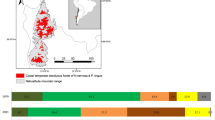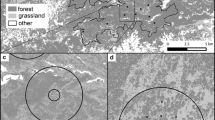Abstract
Time lags in responses of organisms to deteriorating environmental conditions delay population declines and extinctions. We examined how local processes at the population level contribute to extinction debt, and how cycles of habitat deterioration and recovery may delay extinction. We carried out a demographic analysis of the fate of the grassland perennial Primula veris after the cessation of grassland management, where we used either a unidirectional succession model for forest habitat or a rotation model with a period of forest growth followed by a clear-cut and a new successional cycle. The simulations indicated that P. veris populations may have an extinction time of decades to centuries after a detrimental management change. A survey of the current incidence and abundance of P. veris in sites with different histories of afforestation confirmed the simulation results of low extinction rates. P. veris had reduced incidence and abundance only at sites with at least 100 years of forest cover. Time to extinction in simulations was dependent on the duration of the periods with favourable and unfavourable conditions after management cessation, and the population sizes and growth rates in these periods. Our results thus suggest that the ability of a species to survive is a complex function of disturbance regimes, rates of successional change, and the demographic response to environmental changes. Detailed demographic studies over entire successional cycles are therefore essential to identify the environmental conditions that enable long-term persistence and to design management for species experiencing extinction debts.




Similar content being viewed by others

References
Anonymous (1985) Gallringsmallar. Södra Sverige, Skogsstyrelsen
Beissinger SR (1995) Modeling extinction in periodic environments: everglades water levels and snail kite population viability. Ecol Appl 5:618–631. doi:10.2307/1941971
Bierzychudek P (1999) Looking backwards: assessing the projections of a transition matrix model. Ecol Appl 9:1278. doi:10.2307/2641396
Brys R, Jacquemyn H, Endels P, De Blust G, Hermy M (2005) Effect of habitat deterioration on population dynamics and extinction risks in a previously common perennial. Conserv Biol 19:1633–1643. doi:10.1111/j.1523-1739.2005.00216.x
Caswell H (2001) Matrix population models. Sinauer, Sunderland
Cochran ME, Ellner S (1992) Simple methods for calculating age-based life history parameters for stage-structured populations. Ecol Monogr 62:345–364. doi:10.2307/2937115
Colling G, Matthies D (2006) Effects of habitat deterioration on population dynamics and extinction risk of an endangered, long-lived perennial herb (Scorzonera humilis). J Ecol 94:959–972. doi:10.1111/j.1365-2745.2006.01147.x
Crone EE, Menges ES, Ellis MM, Bell T, Bierzychudek P, Ehrlén J, Kaye TN, Knight TM, Lesica P, Morris WF, Oostermeijer G, Quintana-Ascencio PF, Stanley A, Ticktin T, Valverde T, Williams JL (2011) How do plant ecologists use matrix population models? Ecol Lett 14:1–8. doi:10.1111/j.1461-0248.2010.01540.x
Crone EE, Ellis MM, Morris WF, Stanley A, Bell T, Bierzychudek P, Ehrlén J, Kaye TN, Knight TM, Lesica P, Oostermeijer G, Quintana-Ascencio PF, Ticktin T, Valverde T, Williams JL, Doak DF, Ganesan R, McEachern K, Thorpe AS, Menges ES (2013) Ability of matrix models to explain the past and predict the future of plant populations. Conserv Biol 27:968–978. doi:10.1111/cobi.12049
Dahlgren J, Ehrlén J (2011) Incorporating environmental change over succession in an integral projection model of population dynamics of a forest herb. Oikos 120:1183–1190. doi:10.1111/j.1600-0706.2010.19063.x
Development Core Team R (2011) R: a language and environment for statistical computing. R Foundation for Statistical Computing, Vienna
Ehrlén J, Lehtilä K (2002) How perennial are perennial plants? Oikos 98:308–322. doi:10.1034/j.1600-0706.2002.980212.x
Ekstam U, Forshed N (1992) Om hävden upphör. Kärlväxter som indikatorarter i ängs- och hagmarker, Naturvårdsverket
Eriksson O, Ehrlén J (2001) Landscape fragmentation and the viability of plant populations. In: Silvertown J, Antonovics J (eds) Integrating ecology and evolution in a spatial context. Blackwell Science, Oxford, pp 157–175
Evans MEK, Holsinger KE, Menges ES (2010) Fire, vital rates, and population viability: a hierarchical Bayesian analysis of the endangered Florida scrub mint. Ecol Monogr 80:627–649. doi:10.1890/09-1758.1
Faraway JJ (2005) Linear models with R. Chapman and Hall, Boca Raton
Faraway JJ (2006) Extending the linear model with R. Chapman and Hall, Boca Raton
Fischer M, Stöcklin J (1997) Local extinctions of plants in remnants of extensively used calcareous grasslands 1950–1985. Conserv Biol 11:727–737. doi:10.1046/j.1523-1739.1997.96082.x
Gilbert B, Levine JM (2013) Plant invasions and extinction debts. PNAS 110:1744–1749. doi:10.1073/pnas.1212375110
Gonzalez-Andujar JL, Fernandez-Quintanilla C, Navarrete L (2006) Population cycles produced by delayed density dependence in an annual plant. Am Nat 168:318–322. doi:10.1086/506915
Holm S (1979) A simple sequentially rejective multiple test procedure. Scand J Stat 6:65–70
Hylander K, Ehrlén J (2013) The mechanisms causing extinction debts. Trends Ecol Evol 28:341–346. doi:10.1016/j.tree.2013.01.010
Inghe O, Tamm CO (1988) Survival and flowering of perennial herbs. V. Patterns of flowering. Oikos 51:203–219. doi:10.2307/3565644
Jackson ST, Sax DF (2010) Balancing biodiversity in a changing environment: extinction debt, immigration credit and species turnover. Trends Ecol Evol 25:153–160. doi:10.1016/j.tree.2009.10.001
Jacobson S, Pettersson F, Sikström U, Nyström K, Övergaard B (2008) INGVAR: gallringsmall och planeringsinstrument. Skogforsk 10(2008):1–4
Jacquemyn H, Butaye J, Hermy M (2003) Influence of environmental and spatial variables on regional distribution of forest plant species in a fragmented and changing landscape. Ecography 26:768–776. doi:10.1111/j.0906-7590.2003.03620.x
Jonason D, Ibbe M, Milberg P, Tunér A, Westerberg L, Bergman KO (2014) Vegetation in clear-cuts depends on previous land use: a century-old grassland legacy. Ecol Evol 4:4287–4295. doi:10.1002/ece3.1288
Kuussaari M, Bommarco R, Heikkinen RK, Helm A, Krauss J, Lindborg R, Öckinger E, Pärtel M, Pino J, Rodà F, Stefanescu C, Teder T, Zobel M, Steffan-Dewenter I (2009) Extinction debt: a challenge for biodiversity conservation. Trends Ecol Evol 24:564–571. doi:10.1016/j.tree.2009.04.011
Lehtilä K, Syrjänen K, Leimu R, Begoña Garcia M, Ehrlén J (2006) Habitat change and demography of Primula veris: identification of management targets. Conserv Biol 20:833–843. doi:10.1111/j.1523-1739.2006.00368.x
Lindborg R, Ehrlén J (2002) Evaluating the extinction risk of a perennial herb: demographic data versus historical records. Conserv Biol 16:683–690. doi:10.1046/j.1523-1739.2002.00509.x
Lindborg R, Eriksson O (2004) Historical landscape connectivity affects present plant species diversity. Ecology 85:1840–1845. doi:10.1890/04-0367
Lindenmayer DB, Franklin JF (2002) Conserving forest biodiversity: a comprehensive multiscaled approach. Island Press, Washington
Marcante S, Winkler E, Erschbamer B (2009) Population dynamics along a primary succession gradient: do alpine species fit into demographic succession theory? Ann Bot 103:1129–1143. doi:10.1093/aob/mcp047
Merow C, Latimer AM, Wilson AM, McMahon SM, Rebelo AG, Silander JA Jr (2014) On using integral projection models to generate demographically driven predictions of species’ distributions: development and validation using sparse data. Ecography 37:1167–1183. doi:10.1111/ecog.00839
Milberg P (1994) Germination ecology of the polycarpic grassland perennials Primula veris and Trollius europaeus. Ecography 17:3–8. doi:10.1111/j.1600-0587.1994.tb00071.x
Münzbergová Z, Mildén M, Ehrlén J, Herben T (2005) Population viability and reintroduction strategies: a spatially explicit landscape-level approach. Ecol Appl 15:1377–1386. doi:10.1890/04-1464
Ogle K, Reynolds JF (2004) Plant responses to precipitation in desert ecosystems: integrating functional types, pulses, thresholds, and delays. Oecologia 141:282–294. doi:10.1007/s00442-004-1507-5
Quintana-Ascencio PF, Menges ES, Weekley CW (2003) A fire-explicit population viability analysis of Hypericum cumulicola in Florida rosemary scrub. Conserv Biol 17:433–449. doi:10.1046/j.1523-1739.2003.01431.x
Ramula S, Dinnétz P, Lehtilä K (2009) Spatial data replacing temporal data in population viability analyses: an empirical investigation for plants. Basic Appl Ecol 10:401–410. doi:10.1016/j.baae.2008.10.007
Schleuning M, Matthies D (2009) Habitat change and plant demography: assessing the extinction risk of a formerly common grassland perennial. Conserv Biol 23:174–183. doi:10.1111/j.1523-1739.2008.01054.x
Silva JF, Raventos J, Caswell H, Trevisan MC (1991) Population responses to fire in a tropical savanna grass, Andropogon semiberbis: a matrix model approach. J Ecol 79:345–356. doi:10.2307/2260717
Tamm CO (1972) Survival and flowering of some perennial herbs. III. The behaviour of Primula veris on permanent plots. Oikos 23:159–166. doi:10.2307/3543401
Thompson K, Bakker J, Bekker R (1997) The soil seed banks of North West Europe: methodology, density ad longevity. Cambridge University Press, Cambridge
Tilman D, Mary R, Lehman C, Nowak M (1994) Habitat destruction and the extinction debt. Nature 371:65–66. doi:10.1038/371065a0
Tuljapurkar S, Haridas CV (2006) Temporal autocorrelation and stochastic population growth. Ecol Lett 9:327–337. doi:10.1111/j.1461-0248.2006.00881.x
Turchin P (1990) Rarity of density dependence or population regulation with lags? Nature 344:660–663. doi:10.1038/344660a0
Usher MB (1981) Modelling ecological succession, with particular reference to Markovian models. Vegetatio 46:11–18. doi:10.1007/978-94-009-7991-8_2
Valiente-Banuet A, Aizen MA, Alcántara JM, Arroyo J, Cocucci A, Galetti M, García MB, García D, Gómez JM, Jordano P, Medel R, Navarro L, Obeso JR, Oviedo R, Ramírez N, Rey PJ, Traveset A, Verdú M, Zamora R (2015) Beyond species loss: extinction of ecological interactions in a changing world. Funct Ecol 29:299–307. doi:10.1111/1365-2435.12356
Valverde T, Silvertown J (1997) A metapopulation model for Primula vulgaris, a temperate forest understorey herb. J Ecol 85:193–210. doi:10.2307/3546517
Wedderburn F, Richards AJ (1990) Variation in within-morph incompatibility inhibition sites in heteromorphic Primula L. New Phytol 116:149–162. doi:10.1111/j.1469-8137.1990.tb00520.x
Williams DW, Liebhold AM (1995) Detection of delayed density dependence: effects of autocorrelation in an exogenous factor. Ecology 3:1005–1008. doi:10.2307/1939363
Zeileis A, Kleiber C, Jackman S (2008) Regression models for count data in R. J Stat Softw 27(8). doi:10.18637/jss.v027.i08
Acknowledgments
We thank Malte Ehrlén and Juuso Lehtilä for their help in the fieldwork, and Rob Salguero-Gomez and an anonymous referee for comments on the manuscript. The Foundation of Baltic and East European Studies supported the study financially. M. B. G. was funded during the writing by a Spanish National Project (CGL2010-21642).
Author contribution statement
K. L., M. B. G., R. L., K. S. and J. E. planned and carried out the demographic studies. K. L., J. P. D. and J. E. designed the other field studies and the simulations, which K. L. carried out. K. L. had the main responsibility for manuscript writing; the other authors commented and made smaller contributions to the text.
Author information
Authors and Affiliations
Corresponding author
Ethics declarations
Conflict of interest
The authors declare that they have no conflict of interest.
Human participants
This article does not contain any studies with human participants or animals performed by any of the authors.
Legal statement
The experiments comply with the current laws of Sweden and Finland in which the experiments were performed.
Additional information
Communicated by John Dwyer.
Rights and permissions
About this article
Cite this article
Lehtilä, K., Dahlgren, J.P., Garcia, M.B. et al. Forest succession and population viability of grassland plants: long repayment of extinction debt in Primula veris . Oecologia 181, 125–135 (2016). https://doi.org/10.1007/s00442-016-3569-6
Received:
Accepted:
Published:
Issue Date:
DOI: https://doi.org/10.1007/s00442-016-3569-6



